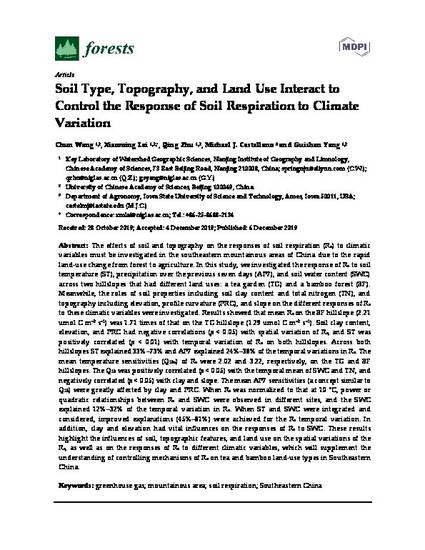
The effects of soil and topography on the responses of soil respiration (Rs) to climatic variables must be investigated in the southeastern mountainous areas of China due to the rapid land-use change from forest to agriculture. In this study, we investigated the response of Rs to soil temperature (ST), precipitation over the previous seven days (AP7), and soil water content (SWC) across two hillslopes that had different land uses: a tea garden (TG) and a bamboo forest (BF). Meanwhile, the roles of soil properties including soil clay content and total nitrogen (TN), and topography including elevation, profile curvature (PRC), and slope on the different responses of Rs to these climatic variables were investigated. Results showed that mean Rs on the BF hillslope (2.21 umol C m−2 s−1) was 1.71 times of that on the TG hillslope (1.29 umol C m−2 s−1). Soil clay content, elevation, and PRC had negative correlations (p < 0.05) with spatial variation of Rs, and ST was positively correlated (p < 0.01) with temporal variation of Rs on both hillslopes. Across both hillslopes ST explained 33%–73% and AP7 explained 24%–38% of the temporal variations in Rs. The mean temperature sensitivities (Q10s) of Rs were 2.02 and 3.22, respectively, on the TG and BF hillslopes. The Q10 was positively correlated (p < 0.05) with the temporal mean of SWC and TN, and negatively correlated (p < 0.05) with clay and slope. The mean AP7 sensitivities (a concept similar to Q10) were greatly affected by clay and PRC. When Rs was normalized to that at 10 °C, power or quadratic relationships between Rs and SWC were observed in different sites, and the SWC explained 12%–32% of the temporal variation in Rs. When ST and SWC were integrated and considered, improved explanations (45%–81%) were achieved for the Rs temporal variation. In addition, clay and elevation had vital influences on the responses of Rs to SWC. These results highlight the influences of soil, topographic features, and land use on the spatial variations of the Rs, as well as on the responses of Rs to different climatic variables, which will supplement the understanding of controlling mechanisms of Rs on tea and bamboo land-use types in Southeastern China.
Available at: http://works.bepress.com/castellano-michael/53/

This article is published as Wang, Chun, Xiaoming Lai, Qing Zhu, Michael J. Castellano, and Guishan Yang. "Soil Type, Topography, and Land Use Interact to Control the Response of Soil Respiration to Climate Variation." Forests 10, no. 12 (2019): 1116. doi: 10.3390/f10121116.